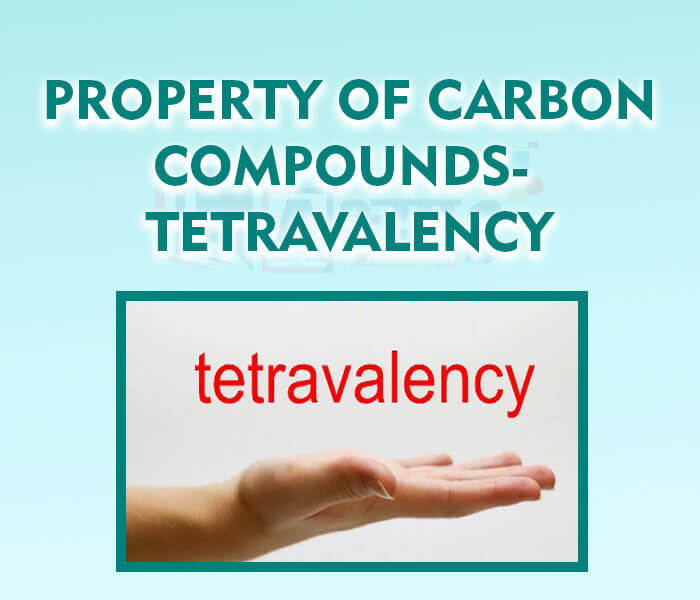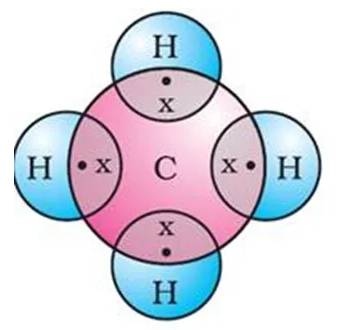Property of Carbon Compounds- Tetravalency







Property of Carbon Compounds- Tetravalency
Carbon belongs to group 14 of the periodic table. Its atomic number is 6 and the electronic configuration is 2, 4. Thus, it has four electrons in the outermost shell. Hence, its valency is i.e. it is capable of bonding or pairing with four other carbon atoms or with the atoms of some other mono-valent elements like hydrogen, halogen (chlorine, bromine) etc.Thus, carbon is tetravalent and can form 4 covalent bonds with not only other atoms but other carbon atoms as well. This is called tetravalency of carbon. It is unique property of carbon as it forms very strong covalent bonds which makes carbon compounds exceptionally stable in nature. Carbon could gain four electrons to form anion or lose four electrons to form
cation. Both these conditions require large amount of energy. Thus it has a very little tendency to form ionic compounds.The ability of carbon to from covalent bonds with other carbon atoms is called Catenation. Due to this property carbon can form long straight, branched and cyclic chains. Carbon can form single, double and triple covalent bonds with other carbon atoms.
The below are the few examples showing the tetravalency of Carbon :

The figure given below is of methane (). Structure of methane shows the sharing of electron between Hydrogen(H) and Carbon(C) atom.

Which of the following are correct : (a) Carbon is tetravalent and can form 4 covalent bonds with not only other atoms but other carbon atoms as well. (b) Carbon could gain four electrons to form | |||
| Right Option : C | |||
| View Explanation | |||
Carbon is ______________________. | |||
| Right Option : D | |||
| View Explanation | |||
How many electrons are present in the outermost shell of Carbon ? | |||
| Right Option : D | |||
| View Explanation | |||
Students / Parents Reviews [10]
Abhyas is a complete education Institute. Here extreme care is taken by teacher with the help of regular exam. Extra classes also conducted by the institute, if the student is weak.

Om Umang
10thAbhyas Methodology is very good. It is based on according to student and each child manages accordingly to its properly. Methodology has improved the abilities of students to shine them in future.

Manish Kumar
10thOne of the best institutes to develope a child interest in studies.Provides SST and English knowledge also unlike other institutes. Teachers are co operative and friendly online tests andPPT develope practical knowledge also.

Aman Kumar Shrivastava
10thIt was a good experience with Abhyas Academy. I even faced problems in starting but slowly and steadily overcomed. Especially reasoning classes helped me a lot.

Cheshta
10thMy experience was very good with Abhyas academy. I am studying here from 6th class and I am satisfied by its results in my life. I improved a lot here ahead of school syllabus.

Ayan Ghosh
8thIt has a great methodology. Students here can get analysis to their test quickly.We can learn easily through PPTs and the testing methods are good. We know that where we have to practice

Barkha Arora
10thMy experience with Abhyas is very good. I have learnt many things here like vedic maths and reasoning also. Teachers here first take our doubts and then there are assignments to verify our weak points.

Shivam Rana
7thI have spent a wonderful time in Abhyas academy. It has made my reasoning more apt, English more stronger and Maths an interesting subject for me. It has given me a habbit of self studying

Yatharthi Sharma
10thAbout Abhyas metholodology the teachers are very nice and hardworking toward students.The Centre Head Mrs Anu Sethi is also a brilliant teacher.Abhyas has taught me how to overcome problems and has always taken my doubts and suppoeted me.

Shreya Shrivastava
8thA marvelous experience with Abhyas. I am glad to share that my ward has achieved more than enough at the Ambala ABHYAS centre. Years have passed on and more and more he has gained. May the centre flourish and develop day by day by the grace of God.
